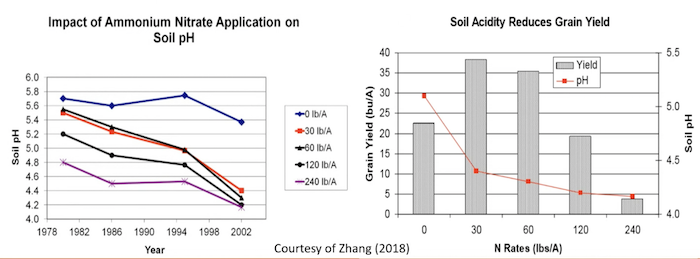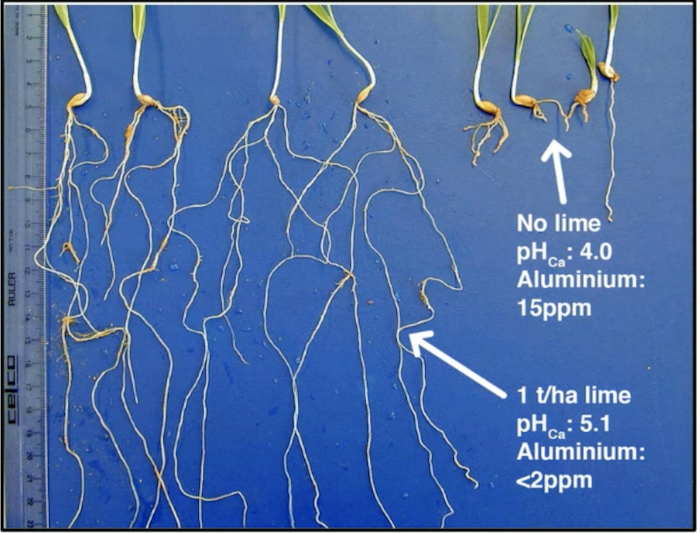For no-tillers, maximizing yields, maintaining healthy soil and fostering robust microbial life requires the correct soil pH. Biological life, water retention, nutrient uptake, herbicide and insecticide effectiveness and yields all suffer in acidic soils.
Soil acidification can occur as a result of natural, beneficial processes, such as rainfall and the decay of organic matter. The year-over-year use of nitrogen (N) fertilizers can also cause it, says João Antonangelo, assistant professor of applied soil chemistry at Washington State University.
“If you have ammonium as a source of inorganic N fertilizer, very quickly it’s going to become nitrate during the oxidation and nitrification process,” Antonangelo says. “From ammonium to nitrate, it releases 4 hydrogens to the soil solution, which acidifies the soil.”
While N fertilizer is often necessary for no-tillers’ crops, this acidification process has a compounding effect that can lead to reduced yields and a continually increasing fertilizer requirement, according to Antonangelo.
N application, regardless of pounds per acre, will progressively reduce soil pH year after year. Rates above 60 pounds per acre will see the most dramatic acidification, reaching pH levels as low as 4.2 and resulting in significant yield losses, according to a 2018 presentation by Hailin Zhang, regent professor of plant and soil sciences at Oklahoma State University. In the study, 30-60 pounds per acre of N tended to result in the highest yields and the least acidification.

YIELD LOSS. Regardless of the amount of nitrogen (N) applied, soil pH will be negatively affected, according to this 2018 study. At 0 pounds of N applied, yields are roughly the same at 120 pounds of N, but the soil pH is significantly lower. Courtesy João Antonangelo
“Every year, farmers apply N based on a yield goal that was previously calibrated by a university or other private lab,” Antonangelo says. “Ongoing application may be giving them good yields, but it’s also acidifying the soil. If they could neutralize their soil pH, they could get even better yields. As an example, wheat cultivars that are resistant or tolerant to low pH and high levels of aluminum will provide greater yields if acidity is neutralized.”
How it Works
When lime is integrated into the soil, it’s dissolved into calcium and carbonate. Carbonate raises the pH by reacting and producing hydroxyls, which react with hydrogen in the soil.
“Carbonate is directly responsible for neutralizing soil acidity,” Antonangelo says. “When it reacts with water, it’s going to form bicarbonate and in that process release hydroxyl to the soil solution. Hydroxyl will react with those hydrogens that are making the soil system very acidic. It’s going to neutralize by forming water. That’s how lime neutralizes acidity.”
No tillage is required for a successful lime application, Antonangelo says, but because lime is not as soluble as other options like gypsum, it takes longer to integrate and take effect. Using a no-tiller’s preferred method to spread lime 2-3 months before planting is Antonangelo’s recommendation and then reapplying every 4-5 years based on soil test results.
If no-tillers could neutralize their soil pH, they could get even better yields...
Determining Lime Needs
To understand the lime requirements of individual fields, Antonangelo recommends conducting comprehensive soil testing that analyzes base saturation, cation exchange capacity, aluminum and soil pH. Then either dolomitic or calcitic lime can be applied to re-establish beneficial nutrient levels. He notes that healthy nutrient balances can allow for plants to grow well at a lower pH, reducing lime requirements and saving no-tillers money.
No-tillers should conduct soil tests at 0-3 inches when using surface or in-furrow applications of nutrients such as N. At depths of 6-12 inches or more, a higher pH may be misleading, according to Antonangelo. Because N is not incorporated into the soil at those depths in no-till fields, the pH at 0-6 inches or more averages out to be higher than it is at the seed zone, where germinating crops need a neutral pH level.
Once soil tests are accurately taken, there are 2 ways to address lime requirements. The first is to add lime to achieve a desired soil pH, which is measured through a buffer pH index. This index measures both active and reserve acidity and determines how resistant the soil is to a change in pH. While active acidity refers to the hydrogen that is dissolved into the soil, reserve acidity is the hydrogen and aluminum that is absorbed into the soil and organic matter. Reserves account for the majority of soil acidity and are released — depending on the buffer capacity — if the soil becomes alkaline.
However, because nutrients in the soil can help crops grow at lower pH levels, a more accurate way to determine lime requirements is through the base saturation approach, according to Antonangelo.

PLANT HEALTH. There was a stark improvement in the root systems of these barley seedlings after about 890 pounds per acre of lime. Soil pH rose from 4 to 5.1, and parts per million of aluminum delcined from 15 to less than 2. Courtesy João Antonangelo
First, it’s important to understand base saturation and cation exchange capacity (CEC) when it appears on soil tests. CEC represents the soil’s capacity to hold and supply nutrients to crops by adding together all basic and acidic cations. Basic cations — or nutrients — include calcium, magnesium and potassium, while acidic cations include hydrogen and aluminum. Base saturation represents how much of the CEC is basic vs. acidic and is expressed as a percentage. A higher base saturation means a higher pH.
Lime needs are calculated by subtracting current base saturation from desired base saturation and multiplying that by the CEC. The resulting number is the agricultural lime requirement in pounds per acre that many soil tests provide.
Meeting a pH goal generally requires more lime application than meeting a base saturation goal because optimum base saturation can be achieved at 70‒80%. In a 2022 study conducted by Antonangelo, he found that the base saturation approach allowed him to achieve the highest yields at a lower pH — meaning less lime needed to be applied — because he was addressing both nutrient availability and pH at the same time.
“In a very acidic, tropical soil, 75% base saturation was good enough to get the best soybean yields at 3.5-4 tonnes of lime per hectare (roughly 1.7 tons per acre),” Antonangelo says. “That base saturation was related to a pH of 5.5, which is much lower than the lower end of that good range of 6-7.”
10-30 parts per million of aluminum is enough to reduce crop yields...
Application & Alternatives
After the quantity of ag lime is determined, the contents of the lime and application method are important considerations.
“Base saturation is going to consider the proportions of calcium, magnesium and potassium in your soil test,” Antonangelo says. “Based on the level of calcium and magnesium in your soil, you can decide whether you’ll use calcitic lime that raises calcium or dolomitic lime that’s richer in magnesium.”
When it comes to the effectiveness of pelletized, liquid or other types of lime, Antonangelo recommends whichever is most affordable.
“If you cannot use lime because it’s too expensive or it’s not available for you for some reason, you can try cheaper options that are going to alleviate the problem in the short term, but they are not going to be as efficient as lime application,” Antonangelo says. “Lime is a long-term solution because you’re also impacting the reserve acidity, not only the acidity in the soil solution.”
This active acidity is what short-term solutions will target. When areas become too acidic, aluminum in the reserve acidity is freed from the soil and can cause aluminum toxicity in crops, stunting root systems and reducing nutrient and water uptake.
“Only a small amount of aluminum, 10-30 parts per million, is enough to reduce crop yields in non-resistant varieties,” Antonangelo says.
These effects can be mitigated by planting aluminum or low-pH resistant crops, he says. A phosphate-based fertilizer is also a short-term solution that works by tying up the aluminum in the soil. Similarly, gypsum, which is more soluble than lime and can be applied 2‒4 weeks prior to planting, breaks down into calcium and sulfate. Sulfate also binds with aluminum but does not neutralize acidity. Gypsum and phosphate simply treat the symptoms of low pH soils, acting as soil conditioners.
Tending to soil pH is as important as addressing nutrient levels and fertilizer needs to foster the best environment for healthy crops.
“A pH close to neutral, 6-7, is where we see the highest levels of plant available nutrients,” Antonangelo says. “This range makes nutrients accessible to other living beings like earthworms, insects and microorganisms that are good for soil health. It also allows pesticides and herbicides to work at their optimum.”
Related Content:
Getting More Effective, Cost-Efficient Lime Applications







Post a comment
Report Abusive Comment